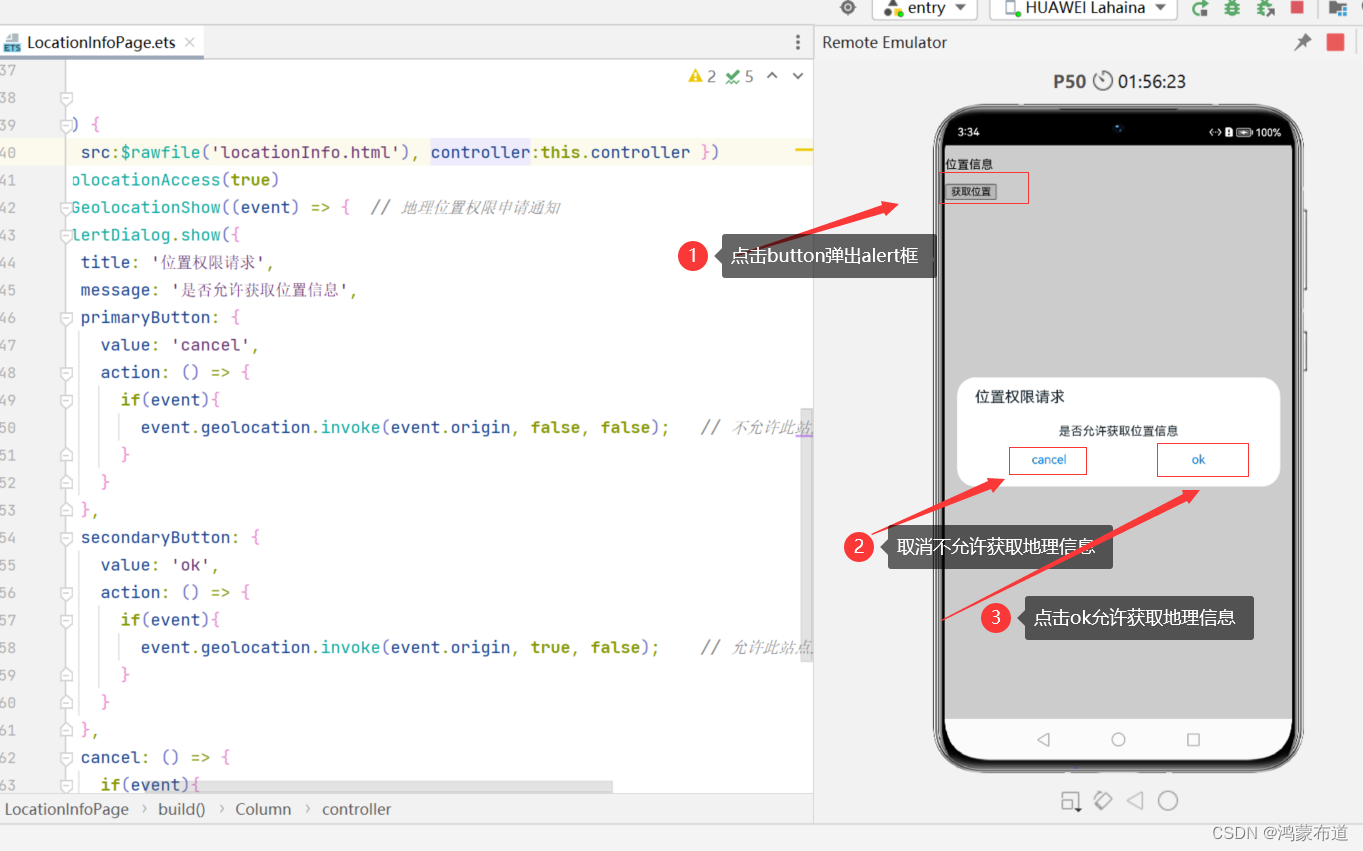- 1手把手做一个公众号GPT智能客服【二】实现微信公众号回复(订阅送源码!)_微信公众号回复消息接入大模型
- 2一文教你如何在ThinkPHP6中玩转路由,提升开发效率!_thinkphp6路由
- 32023第三届人工智能与机器学习国际学术会议(ICMLAI 2023)_icmlca 2023 收费
- 4Hugging Face——MLM预训练掩码语言模型方法_掩码语言预训练
- 5探索PyTorch的自然语言理解与知识图谱
- 6机器学习技术(三)——机器学习实践案例总体流程_机器学习案例实习
- 7《自然语言处理综论(Speech and Language Processing)》第九章笔记_自然语言处理综论中文版
- 8基于深度学习LSTM+NLP情感分析电影数据爬虫可视化分析推荐系统(深度学习LSTM+机器学习双推荐算法+scrapy爬虫+NLP情感分析+数据分析可视化)_基于lstm的电影推荐系统
- 9文献学习-23-MRM:用于遗传学医学图像预训练的掩码关系建模
- 10OpenCV联通组件扫描
鸿蒙开发-web
赞
踩
文章目录
前言
一、web组件概述
Web组件用于在应用程序中显示Web页面内容,为开发者提供页面加载、页面交互、页面调试等能力

二、web组件加载页面
页面加载若涉及网络资源获取,需要配置ohos.permission.INTERNET网络访问权限
1.加载网络页面
Web组件创建的时候可以指定默认加载的网络页面 。在默认页面加载完成后,可以通过调用loadUrl()接口加载指定网络网页
代码示例
- //step1:导入依赖webview
- import web_webview from '@ohos.web.webview';
-
- @Entry
- @Component
- struct WebComponent {
- webviewController: web_webview.WebviewController = new web_webview.WebviewController();
-
- build() {
- Column() {
- Button('loadUrl')
- .onClick(() => {
- try {
- //step3:点击按钮时,通过loadUrl,跳转到指定的网页www.example1.com
- this.webviewController.loadUrl('www.example1.com');
- } catch (error) {
- console.error(`ErrorCode: ${error.code}, Message: ${error.message}`);
- }
- })
- //step2:定义Web组件创建时,加载www.example.com
- Web({ src: 'www.example.com', controller: this.webviewController})
- }
- }
- }

2.加载本地页面
将本地页面文件放在应用的rawfile目录下,Web组件创建的时候指定默认加载的本地页面 ,并且加载完成后可通过调用loadUrl()接口变更当前Web组件的页面
step1:创建本地html文件local.html
- <!DOCTYPE html>
- <html>
- <body>
- <p>Hello World</p>
- </body>
- </html>
step2:将本地文件local.htm放置在应用的resources/rawfile目录下

step3:应用代码
- import web_webview from '@ohos.web.webview';
-
- @Entry
- @Component
- struct WebComponent {
- webviewController: web_webview.WebviewController = new web_webview.WebviewController();
-
- build() {
- Column() {
- Button('loadUrl')
- .onClick(() => {
- try {
- //step2:点击按钮时,通过loadUrl,跳转到本地其他html文件 local1.html
- this.webviewController.loadUrl($rawfile("local1.html"));
- } catch (error) {
- console.error(`ErrorCode: ${error.code}, Message: ${error.message}`);
- }
- })
- //step1:组件Web组件,通过$rawfile加载本地文件local.html
- Web({ src: $rawfile("local.html"), controller: this.webviewController })
- }
- }
- }

3.加载html格式文本数据
Web组件可以通过loadData接口实现加载HTML格式的文本数据。当开发者不需要加载整个页面,只需要显示一些页面片段时,可通过此功能来快速加载页面
代码示例
- import web_webview from '@ohos.web.webview';
-
- @Entry
- @Component
- struct WebComponent {
- controller: web_webview.WebviewController = new web_webview.WebviewController();
-
- build() {
- Column() {
- Button('loadData')
- .onClick(() => {
- try {
- //step2:点击按钮时,通过loadData,加载HTML格式的文本数据
- this.controller.loadData(
- "<html><body bgcolor=\"white\">Source:<pre>source</pre></body></html>",
- "text/html",
- "UTF-8"
- );
- } catch (error) {
- console.error(`ErrorCode: ${error.code}, Message: ${error.message}`);
- }
- })
- //step1:组件创建时,默认加载www.example.com
- Web({ src: 'www.example.com', controller: this.controller })
- }
- }
- }

三、设置基本属性和事件
1. 设置深色模式
1.1 darkMode
darkMode接口可以配置不同的深色模式
代码示例:
- import web_webview from '@ohos.web.webview';
-
- @Entry
- @Component
- struct WebComponent {
- controller: web_webview.WebviewController = new web_webview.WebviewController();
- //step1:定义深色模式:WebDarkMode.Off模式表示关闭深色模式;WebDarkMode.On表示开启深色模式,并且深色模式跟随前端页面;WebDarkMode.Auto表示开启深色模式,并且深色模式跟随系统
- @State mode: WebDarkMode = WebDarkMode.Auto;
- build() {
- Column() {
- //step2:darkMode接口配置step1定义的深色模式
- Web({ src: 'www.example.com', controller: this.controller })
- .darkMode(this.mode)
- }
- }
- }

1.2 forceDarkAccess
forceDarkAccess接口可将前端页面强制配置深色模式,且深色模式不跟随前端页面和系统。配置该模式时候,需要将深色模式配置成WebDarkMode.On。
代码示例:
- import web_webview from '@ohos.web.webview';
-
- @Entry
- @Component
- struct WebComponent {
- controller: web_webview.WebviewController = new web_webview.WebviewController();
- //step1:forceDarkAccess要求WebDarkMode必须为on
- @State mode: WebDarkMode = WebDarkMode.On;
- @State access: boolean = true;
- build() {
- Column() {
- Web({ src: 'www.example.com', controller: this.controller })
- .darkMode(this.mode)
- //step2:页面强制配置为深色模式
- .forceDarkAccess(this.access)
- }
- }
- }

2. 上传文件
Web组件支持前端页面选择文件上传功能,onShowFileSelector()接口处理前端页面文件上传的请求
step1:创建本地html文件 local.html
- <html>
- <head>
- <meta charset="utf-8">
- <title>Document</title>
- </head>
-
- <body>
- // 点击文件上传按钮
- <input type="file" value="file"></br>
- </body>
- </html>
step2:本地local.html文件放置到对应目录下
step3:应用侧代码
- import web_webview from '@ohos.web.webview';
- @Entry
- @Component
- struct WebComponent {
- controller: web_webview.WebviewController = new web_webview.WebviewController()
- build() {
- Column() {
- //step1:加载本地local.html页面
- Web({ src: $rawfile('local.html'), controller: this.controller })
- //step2:当用户在前端页面点击文件上传按钮,应用侧在onShowFileSelector()接口中收到文件上传请求,在此接口中开发者将上传的本地文件路径设置给前端页面
- .onShowFileSelector((event) => {
- let fileList: Array<string> = [
- 'xxx/test.png',
- ]
- if(event){
- event.result.handleFileList(fileList)
- }
- return true;
- })
- }
- }
- }

3. 在新窗口打开页面
Web组件提供了在新窗口打开页面的能力,通过multiWindowAccess()接口来设置是否允许网页在新窗口打开。当有新窗口打开时,应用侧会在onWindowNew()接口中收到Web组件新窗口事件,开发者需要在此接口事件中,新建窗口来处理Web组件窗口请求。
4. 管理位置权限
Web组件提供位置权限管理能力,通过onGeolocationShow()接口对某个网站进行位置权限管理。Web组件根据接口响应结果,决定是否赋予前端页面权限。获取设备位置,需要开发者配置ohos.permission.LOCATION权限。
step1:定义本地页面
- <!DOCTYPE html>
- <html>
- <body>
- <p id="locationInfo">位置信息</p>
- <button onclick="getLocation()">获取位置</button>
- <script>
- var locationInfo=document.getElementById("locationInfo");
- function getLocation(){
- if (navigator.geolocation) {
- <!-- 前端页面访问设备地理位置 -->
- navigator.geolocation.getCurrentPosition(showPosition);
- }
- }
- function showPosition(position){
- locationInfo.innerHTML="Latitude: " + position.coords.latitude + "<br />Longitude: " + position.coords.longitude;
- }
- </script>
- </body>
- </html>

step2:应用侧代码
- import web_webview from '@ohos.web.webview';
- import common from '@ohos.app.ability.common';
- import abilityAccessCtrl from '@ohos.abilityAccessCtrl';
- import geoLocationManager from '@ohos.geoLocationManager';
-
- let context = getContext(this) as common.UIAbilityContext;
- let atManager = abilityAccessCtrl.createAtManager();
-
- try{
- atManager.requestPermissionsFromUser(context, ["ohos.permission.APPROXIMATELY_LOCATION"], (err, data) => {
- let requestInfo: geoLocationManager.LocationRequest = {
- 'priority': 0x203,
- 'scenario': 0x300,
- 'maxAccuracy': 0
- };
- let locationChange = (location: geoLocationManager.Location):void => {
- if(location){
- console.log('locationChanger: location=' + JSON.stringify(location));
- }
- };
- try{
- geoLocationManager.on('locationChange', requestInfo, locationChange);
- geoLocationManager.off('locationChange', locationChange);
- } catch (err) {
- console.error("errCode:" + err.code + ", errMessage:" + err.message);
- }
- })
- } catch (err) {
- console.error("err:", err);
- }
-
- @Entry
- @Component
- struct WebComponent {
- controller: web_webview.WebviewController = new web_webview.WebviewController();
- build() {
- Column() {
- Web({ src:$rawfile('getLocation.html'), controller:this.controller })
- .geolocationAccess(true)
- .onGeolocationShow((event) => { // 地理位置权限申请通知
- AlertDialog.show({
- title: '位置权限请求',
- message: '是否允许获取位置信息',
- primaryButton: {
- value: 'cancel',
- action: () => {
- if(event){
- event.geolocation.invoke(event.origin, false, false); // 不允许此站点地理位置权限请求
- }
- }
- },
- secondaryButton: {
- value: 'ok',
- action: () => {
- if(event){
- event.geolocation.invoke(event.origin, true, false); // 允许此站点地理位置权限请求
- }
- }
- },
- cancel: () => {
- if(event){
- event.geolocation.invoke(event.origin, false, false); // 不允许此站点地理位置权限请求
- }
- }
- })
- })
- }
- }
- }

页面渲染,web组件中默认加载locationInfo.html页面

总结
本文学习了鸿蒙开发web相关的知识,了解web组件的基本概念,以及加载页面的三种方式,同时也学习了web组件的的基本属性和事件,下文将学习web的其他知识。


